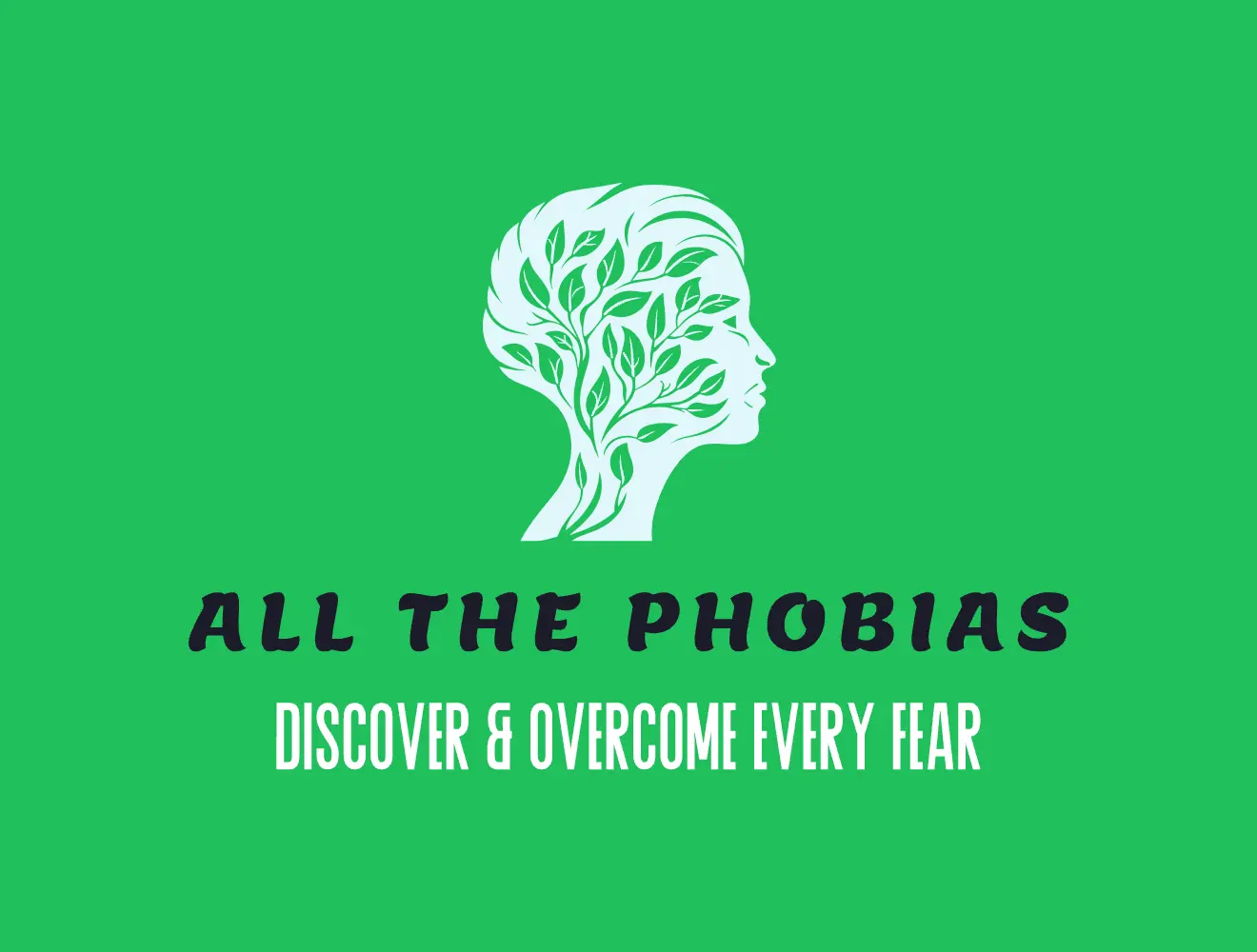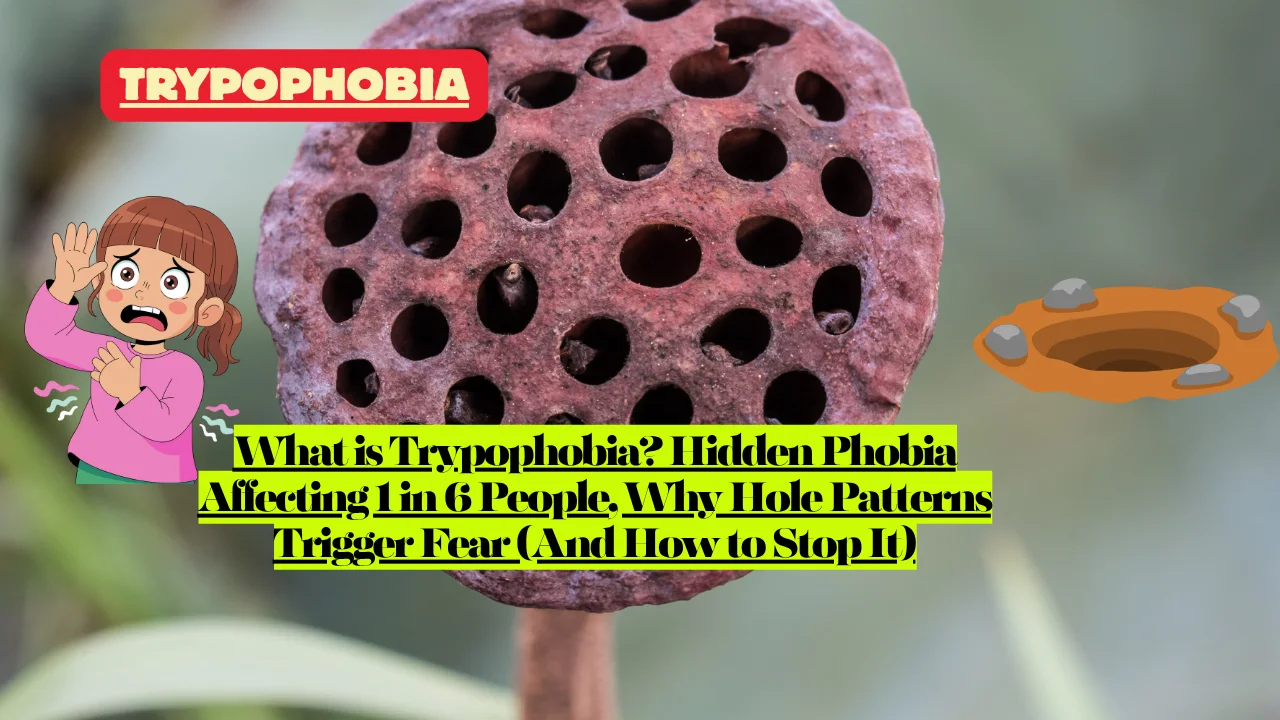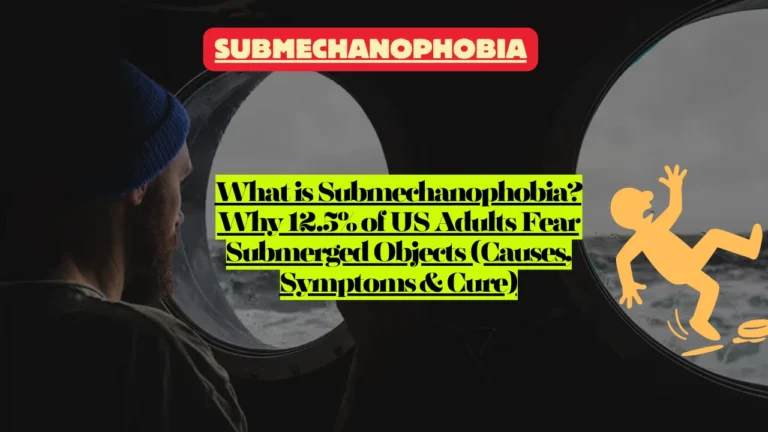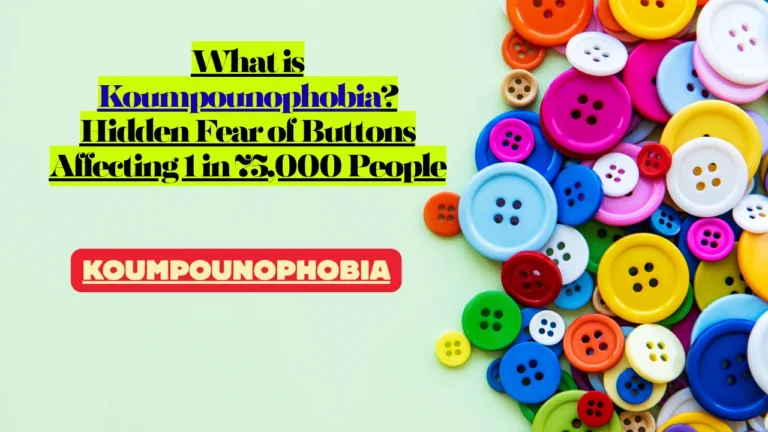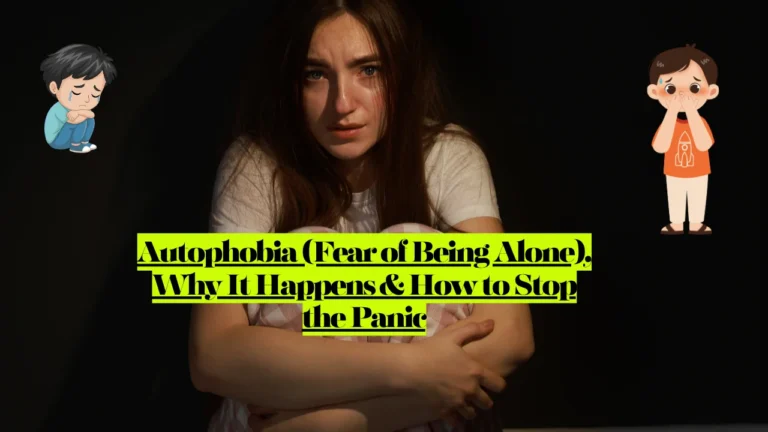What Exactly is Trypophobia?
Trypophobia is an intense fear or disgust reaction to clusters of small holes, repetitive patterns, or bumps. Unlike general discomfort with unusual images, trypophobia triggers genuine physiological and psychological responses that can significantly impact your quality of life.
The Official Definition
While trypophobia hasn’t yet been officially recognized as a separate diagnosis in the DSM-5 (Diagnostic and Statistical Manual of Mental Disorders), it may fall under the category of “specific phobia” when it causes excessive fear or distress that interferes with daily functioning.
What makes it a clinical concern? Research shows that individuals with trypophobia can suffer clinically significant morbidity and comorbidity—meaning it can seriously affect your mental health, work performance, and relationships.
Why “Just a Fear of Holes” Doesn’t Capture It
Many people with trypophobia report that the term “fear” doesn’t fully describe their experience. Research reveals:
- 60.5% experience mostly disgust (not fear)
- 21% experience equal amounts of fear and disgust
- 11.8% experience only disgust
- 5.1% experience mostly fear
- 1% experience only fear
This disgust-dominant response suggests trypophobia may work differently in your brain than traditional phobias like fear of heights or spiders.
Does This Sound Like You?
You’re scrolling through your phone when suddenly—there it is. A close-up of a lotus pod. Your stomach drops. Your skin crawls. You feel an overwhelming urge to look away, but the image is burned into your mind. Your heart races, and you feel slightly nauseous.
You’re not losing your mind. You’re experiencing trypophobia—and you’re far from alone.
Take This 60-Second Self-Assessment
Answer YES or NO to these questions:
- Do you feel intense discomfort, disgust, or anxiety when seeing clusters of small holes?
- Have you avoided certain foods, places, or situations because of hole patterns?
- Do you experience physical symptoms (nausea, goosebumps, rapid heartbeat) when viewing honeycomb, lotus pods, or similar patterns?
- Does this fear interfere with your work, hobbies, or daily activities?
- Do images of hole clusters stay in your mind long after you’ve seen them?
If you answered YES to 2 or more questions, you likely have trypophobia. But here’s the good news: 90% of people who complete treatment see significant improvement, and 65% become completely symptom-free within four years.
“After 6 months of treatment, I can now work on graphic design projects I once had to turn down. My career is back on track, and I feel in control again.” — Sarah M., Graphic Designer
Quick Facts About Trypophobia
| Statistic | What It Means for You |
| 10-18% of population affected | Approximately 1 in 6 people—you’re definitely not alone |
| 90% treatment success rate | Exposure therapy is highly effective for those who complete it |
| 65% become symptom-free | At 4-year follow-up, most people have no remaining symptoms |
| First named in 2005 | This is a newly recognized condition gaining scientific validation |
| More common than you think | Affects as many people as fear of heights or spiders |
🎯 Your Goal for This Article: Understand what you’re experiencing, why it happens, and discover the proven path to recovery that’s helped thousands of people reclaim their lives.
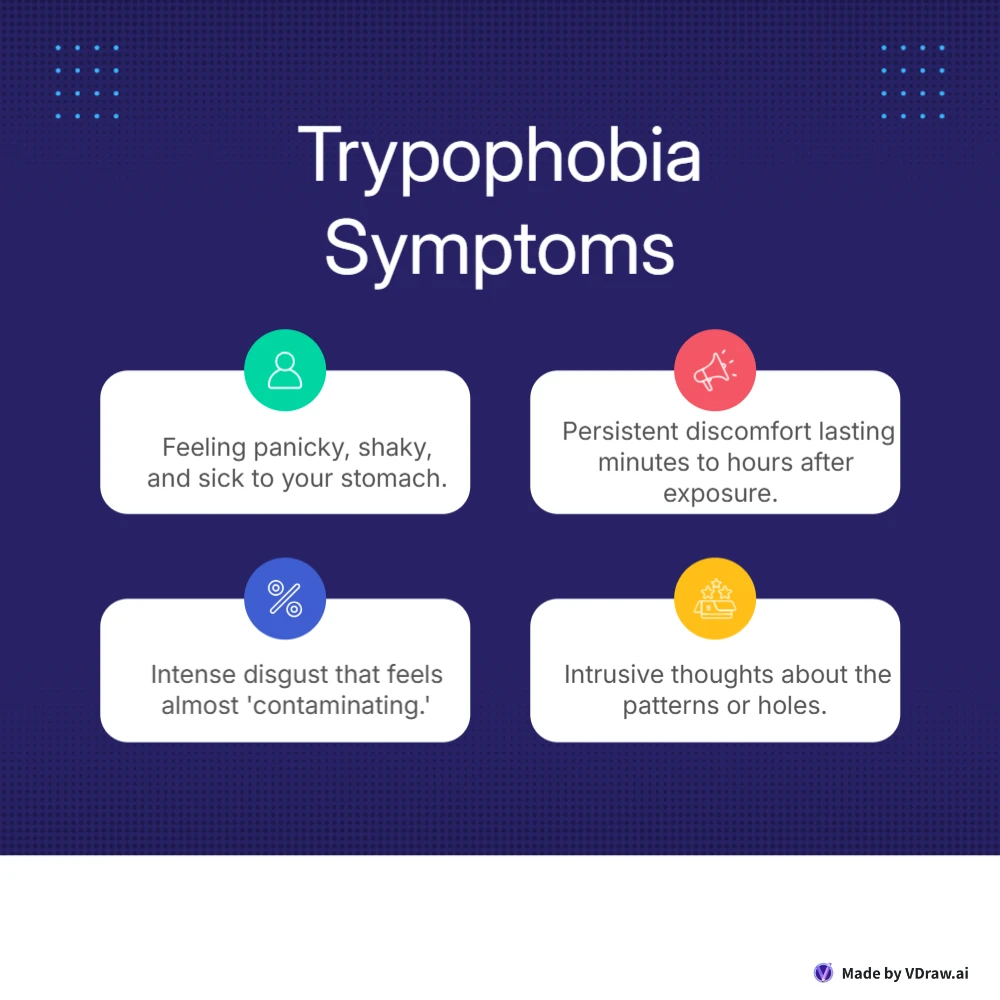
Do You Have Trypophobia? Complete Symptom Checklist
Physical Symptoms (Your Body’s Response)
When you encounter trypophobic triggers, your brain sends distress signals throughout your body—even when you rationally know the image isn’t dangerous. Common physical responses include:
Immediate Physical Reactions:
- ✓ Feeling panicky, shaky, and sick to your stomach
- ✓ Sweating and rapid heartbeat or palpitations
- ✓ Nausea and strong urge to vomit
- ✓ Goosebumps and intense “skin crawling” sensations
- ✓ Trembling or shaking when viewing triggering images
- ✓ Difficulty breathing or shortness of breath
- ✓ Dizziness or feeling lightheaded
- ✓ Muscle tension, especially in shoulders and neck
- ✓ Hot flashes or chills
Delayed Physical Responses:
- ✓ Persistent discomfort lasting minutes to hours after exposure
- ✓ Fatigue from the intense stress response
- ✓ Difficulty sleeping after seeing triggering images
- ✓ Tension headaches
Emotional & Mental Responses
People with trypophobia commonly experience powerful emotional reactions:
During Exposure:
- ✓ Intense disgust that feels almost “contaminating”
- ✓ Fear and anxiety ranging from mild uneasiness to severe panic
- ✓ Feeling overwhelmed or out of control
- ✓ Irrational but powerful urge to escape immediately
- ✓ Sense of being “violated” or “invaded” by the pattern
After Exposure:
- ✓ Intrusive thoughts about the patterns or holes
- ✓ Mental images that won’t go away
- ✓ Persistent thoughts about the triggering image
- ✓ Difficulty concentrating on other tasks
- ✓ Heightened sensitivity to potential triggers in environment
- ✓ Anticipatory anxiety about encountering triggers again
Behavioral Changes (How It Affects Your Life)
Trypophobic individuals often develop avoidance behaviors that can significantly limit their daily activities:
Active Avoidance:
- ✓ Actively avoiding places where triggers might appear (gardens, nature areas, certain stores)
- ✓ Covering eyes or turning away immediately from triggering images
- ✓ Scrolling quickly past social media content
- ✓ Checking environments beforehand for potential triggers
- ✓ Leaving rooms or situations when triggers appear
Life Limitations:
- ✓ Limiting certain activities (gardening, cooking specific foods, shopping in certain stores)
- ✓ Asking others to handle tasks involving potential triggers
- ✓ Avoiding certain careers or educational paths
- ✓ Declining social invitations to avoid potential exposure
- ✓ Restricting media consumption (avoiding certain shows, websites, apps)
🚨 When It Becomes Clinically Significant:
Your trypophobia reaches clinical significance when:
- The fear significantly interferes with your daily functioning
- It impacts your work performance or career choices
- It affects your relationships or social life
- You experience severe distress that doesn’t improve with time
- You’ve developed depression or other anxiety symptoms alongside it
Related Phobia: What is Nomophobia? 66% Struggle with Phone Separation Anxiety, Causes & Treatment
Understanding Trypophobia: What Causes This Fear?
The Science Behind It
Spectral features of visual stimuli characterized by high-contrast energy at midrange spatial frequencies have been considered to underlie the condition. Recent research from 2024 provides new insights into why this fear develops:
Neurological Mechanisms: The fear response appears to be triggered by specific visual patterns that our brain interprets as potentially dangerous. Some researchers suggest that this may occur due to recognizing the pattern as a danger, whereas others see it as simply experiencing disgust
Evolutionary Explanations: Many researchers believe trypophobia may have evolutionary roots – our ancestors who feared cluster patterns (which could indicate disease, parasites, or dangerous animals) were more likely to survive. Recent 2024 research has explored the social learning account of trypophobia, suggesting we may learn these responses from others in our environment
Individual Differences: Some people might find all closely packed holes uncomfortable and upsetting, while others only react to specific types of patterns. The severity varies greatly between individuals.
Development Patterns
Learned Responses: Classical conditioning can play a role – if someone has a negative experience associated with hole patterns, they may develop a lasting fear response.
Childhood vs. Adult Onset: While trypophobia can develop at any age, many people report noticing their reactions in childhood or adolescence. Studies suggest that as many as 17% of children and adults have some degree of trypophobia
Cultural and Social Factors: Around 10–18% of the population reportedly affected, with this aversion often documented as a response to images shared through social media and online platforms, suggesting cultural transmission may play a role.
Risk Factors
Genetic Predisposition: Family history of anxiety disorders or specific phobias may increase likelihood of developing trypophobia.
Personality Traits: Individuals with higher sensitivity to disgust or visual processing differences may be more susceptible.
Co-occurring Conditions: Research has investigated whether trypophobia most resembled a specific phobia or obsessive-compulsive disorder, suggesting possible connections to other anxiety-related conditions.
How It Differs From Normal Fear
Clinical Diagnostic Considerations: In the Diagnostic and Statistical Manual of Mental Disorders (DSM)-5, phobias receive the name of specific phobias and are classified according to their trigger. However, trypophobia has not yet been recognized by diagnostic taxonomies such as the DSM
Duration and Intensity: Normal discomfort with unusual patterns is temporary and mild. Trypophobia involves persistent, intense reactions that may last long after exposure.
Functional Impairment: The key difference is whether the fear significantly impacts your daily life, work, or relationships.
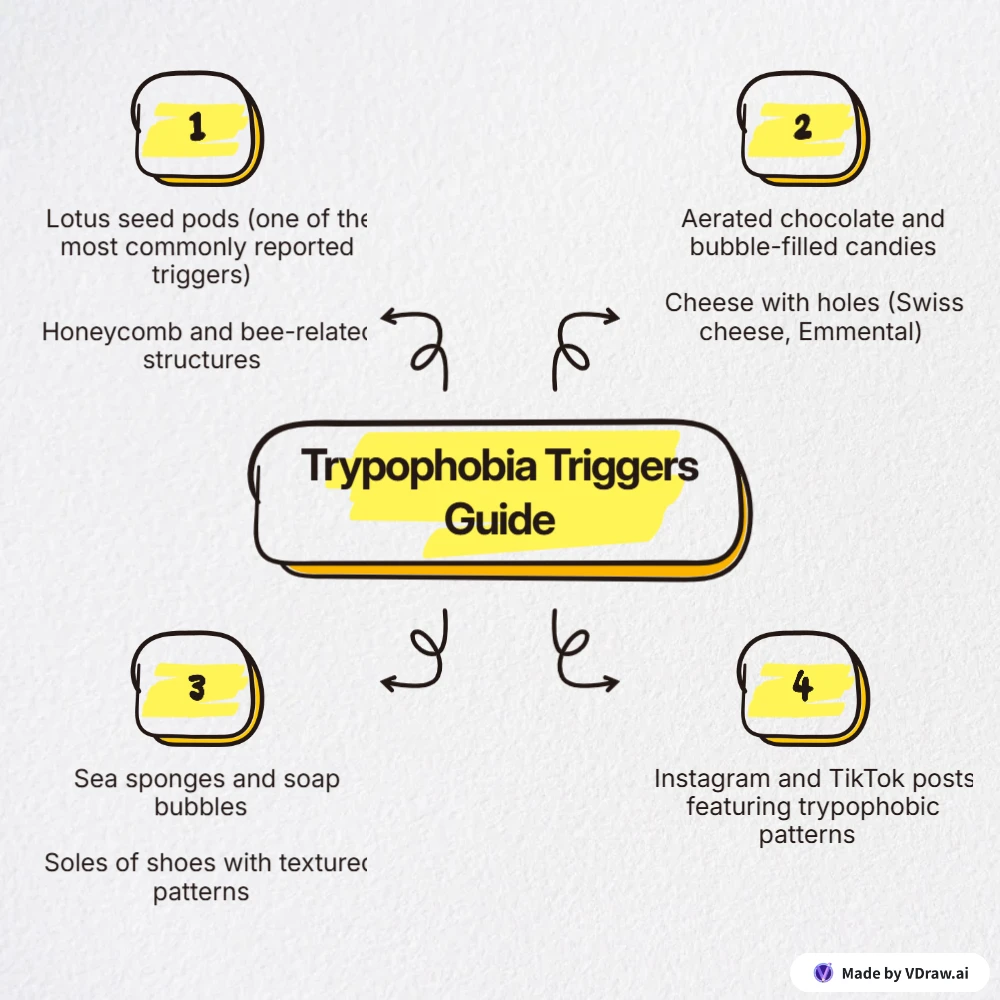
Comprehensive Triggers & Situations: Complete Guide to Trypophobia Triggers
Natural Patterns and Objects
Biological Triggers:
- Lotus seed pods (one of the most commonly reported triggers)
- Honeycomb and bee-related structures
- Skin on snakes, lizards, frogs and other reptiles
- Coral and sea sponges
- Tree bark with holes from insects
- Sunflower centers and seed heads
- Pomegranate interior
- Strawberry surfaces
- Cantaloupe and honeydew melon textures
- Toad skin and amphibian patterns
Food-Related Triggers:
- Aerated chocolate and bubble-filled candies
- Cheese with holes (Swiss cheese, Emmental)
- Bread with air pockets (sourdough, baguettes)
- Crumpets and English muffins
- Pasta shapes with holes (rigatoni, penne)
- Cereal with holes (Cheerios, Life cereal)
Human-Made Objects
Everyday Items:
- Sea sponges and soap bubbles
- Soles of shoes with textured patterns
- Colanders and strainers
- Speaker grilles and mesh patterns
- Bubble wrap (especially when popped)
- Perforated paper and materials
- Drainage covers and grates
- Chain-link fencing close-up
Architecture and Design:
- Building facades with repetitive window patterns
- Perforated metal designs
- Acoustic ceiling tiles
- Decorative screens and room dividers
Modern Digital Triggers
Social Media Content:
- Instagram and TikTok posts featuring trypophobic patterns
- Viral images designed to trigger trypophobia reactions
- Close-up photography of natural patterns
- Art installations using hole patterns
Entertainment Media:
- Horror movies using trypophobic imagery
- Video games with clustered hole patterns
- Virtual reality environments with triggering visuals
- Streaming content with unexpected trypophobic scenes
Workplace & Educational Settings
Professional Environments:
- Medical settings with perforated equipment
- Manufacturing environments with mesh or perforated materials
- Graphic design work involving pattern creation
- Scientific research requiring examination of cellular or molecular patterns
Educational Scenarios:
- Biology classes studying cellular structures
- Geology courses examining rock formations
- Art classes working with pattern-based designs
- Photography courses focusing on macro imagery
Real-World Impact & Life Challenges
Brief Example: Sarah, a graphic designer, discovered her trypophobia was affecting her career when she couldn’t complete projects involving clustered patterns. She would experience panic attacks when clients requested designs with repetitive hole patterns. After seeking treatment and learning coping strategies, she was able to develop techniques to manage her fear while maintaining her successful design career.
Common Life Areas Affected
Work and Career Implications:
- Graphic designers avoiding certain pattern work
- Healthcare workers struggling with medical equipment
- Teachers unable to use certain visual aids
- Photographers limiting their subject matter
- Food service workers avoiding specific food preparation
Relationships and Social Situations:
- Difficulty participating in certain group activities
- Avoiding restaurants that serve triggering foods
- Social isolation when triggers are present in group settings
- Impact on family activities (avoiding certain outdoor locations)
- Challenges with gift-giving (avoiding certain decorative items)
Personal Activities and Hobbies:
- Gardening limitations when dealing with seed pods or insect damage
- Cooking restrictions with certain foods and ingredients
- Shopping difficulties when encountering triggering products
- Travel limitations to avoid certain natural environments
- Craft and art hobby restrictions
Decision-Making and Life Choices:
- Home decoration and furniture selection influenced by trigger avoidance
- Career path decisions based on potential exposure to triggers
- Educational choices avoiding fields with relevant visual content
- Technology usage patterns (avoiding certain websites or apps)
Treatment & Recovery Options: Proven Ways to Overcome Trypophobia
Professional Treatment (Most Effective)
Cognitive Behavioral Therapy (CBT): Studies show that exposure therapy helps over 90% of people with a specific phobia who commit to the therapy and complete it. For specific phobias, considerable pre-post effect sizes of d = 1.3 have been found in clinical research.
How CBT Works:
- Identifying and challenging negative thought patterns about hole clusters
- Learning relaxation techniques to manage physical symptoms
- Developing coping strategies for unexpected trigger encounters
- Gradual exposure combined with cognitive restructuring
- Typical treatment duration ranges from 12-20 sessions
Exposure Therapy: At a post-treatment follow-up four years later 90% of people retained a considerable reduction in fear, avoidance, and overall level of impairment, while 65% no longer experienced any symptoms of a specific phobia. This involves:
- Starting with less triggering images or patterns
- Gradually increasing exposure intensity over time
- Learning to tolerate discomfort without avoidance
- Building confidence in ability to cope with triggers
- Success rates for exposure therapy show that individuals learn they can tolerate the fear, that the fear will come down on its own without avoiding or escaping
Other Professional Treatment Options:
Eye Movement Desensitization and Reprocessing (EMDR): Particularly effective if trypophobia developed following a traumatic experience involving clustered patterns.
Acceptance and Commitment Therapy (ACT): Focuses on accepting the fear response while committing to valued life activities despite the presence of triggers.
Medication Support:
- Anti-anxiety medications for severe cases (typically short-term use)
- Beta-blockers for physical symptoms in specific situations
- SSRIs if trypophobia co-occurs with other anxiety disorders
- Medication is usually combined with therapy rather than used alone
Self-Help Strategies
Breathing Techniques:
- 4-7-8 breathing: Inhale for 4, hold for 7, exhale for 8
- Progressive muscle relaxation starting from toes to head
- Mindfulness meditation focusing on present moment awareness
Grounding Exercises:
- 5-4-3-2-1 technique: Identify 5 things you see, 4 you hear, 3 you touch, 2 you smell, 1 you taste
- Physical grounding: Feel feet on floor, hands on solid surfaces
- Mental grounding: Recite facts about yourself or your environment
Gradual Self-Exposure (with Safety Guidelines):
- Start with cartoon or highly stylized representations of patterns
- Use breathing techniques during brief exposures
- Gradually increase exposure time as comfort improves
- Never force exposure that causes severe panic
- Always have support person available if needed
Lifestyle Modifications:
- Regular exercise to reduce overall anxiety levels
- Adequate sleep to improve emotional regulation
- Limiting caffeine which can increase anxiety symptoms
- Joining online support groups for shared experiences and coping strategies
When to Seek Professional Help
Seek professional treatment if you experience:
- Panic attacks when encountering triggers
- Significant interference with work, relationships, or daily activities
- Persistent avoidance limiting your life choices
- Physical symptoms that don’t improve with self-help techniques
- Co-occurring depression or other anxiety disorders
- Thoughts of self-harm related to your fear
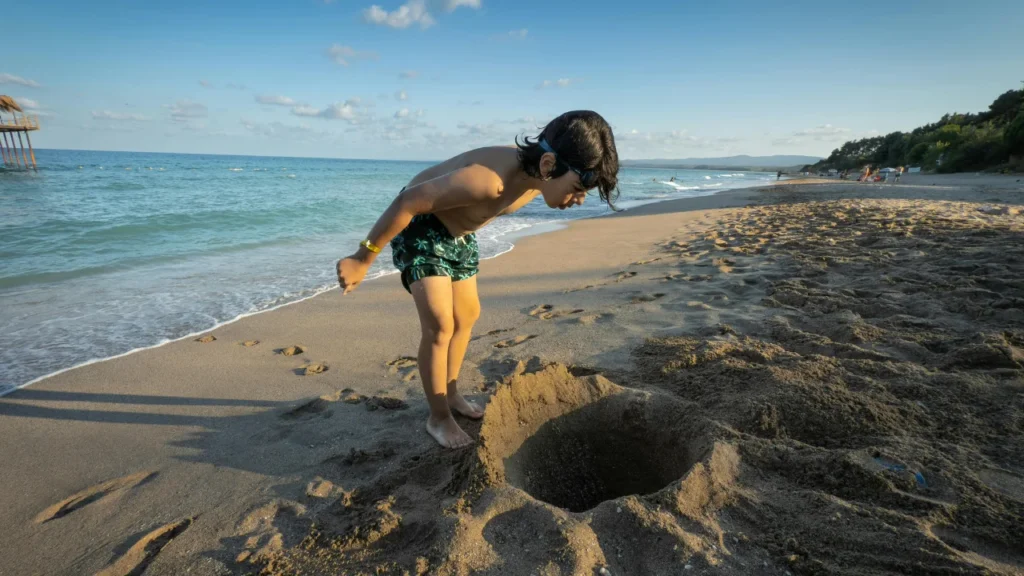
Support & Next Steps: Your Path Forward
Finding Professional Help
Types of Specialists to Look For:
- Licensed clinical psychologists specializing in anxiety disorders
- Psychiatrists with experience in specific phobias
- Licensed clinical social workers (LCSW) with CBT training
- Licensed marriage and family therapists (LMFT) with anxiety specialization
Questions to Ask Potential Therapists:
- “What experience do you have treating specific phobias?”
- “Are you familiar with trypophobia specifically?”
- “What treatment approaches do you use for phobia treatment?”
- “How do you typically structure exposure therapy?”
- “What’s your success rate with specific phobia treatment?”
Insurance and Cost Considerations:
- Check if your insurance covers mental health services
- Ask about sliding scale fees if cost is a concern
- Many therapists offer brief consultations to determine fit
- Employee Assistance Programs (EAP) may provide free sessions
Building Your Support System
How Family and Friends Can Help:
- Learn about trypophobia to better understand your experience
- Provide emotional support without minimizing your fears
- Help identify and avoid triggers when appropriate
- Encourage professional treatment when needed
- Participate in treatment process if therapist recommends
Online Communities and Resources:
- Join AllThePhobias.com community forums for peer support
- Connect with others who understand trypophobia experiences
- Share coping strategies and success stories
- Access educational resources and treatment information
What NOT to Do (Common Mistakes):
- Forcing exposure to “cure” the phobia quickly
- Dismissing the fear as “silly” or “not real”
- Avoiding all potential triggers indefinitely
- Using alcohol or substances to cope with anxiety
- Attempting to “shock” someone out of their phobia
Remember Your Path to Recovery
Recovery Statistics to Inspire Hope: While specific data for trypophobia is still emerging due to its recent recognition, treatment success rates for specific phobias are very encouraging – most people who complete treatment experience significant improvement or complete recovery.
Validation: Given that individuals with trypophobia suffer clinically significant morbidity and comorbidity, this condition deserves further attention from clinicians and researchers. Seeking help is a smart, proactive choice, not a sign of weakness.
Your Connection to Support: The AllThePhobias.com community is here to provide ongoing support, resources, and connection with others who understand your experience. You’re not alone in this journey.
Ready to take the first step? Connect with qualified therapists specializing in anxiety and phobic disorders through our professional directory, or explore our comprehensive self-help resources to begin your recovery journey today.
Frequently Asked Questions About Trypophobia Aka Fear of Holes
Is trypophobia a real phobia?
Yes, trypophobia is a real condition that affects approximately 10–18% of the adult population. While not clinically recognized as a separate mental disorder in diagnostic manuals like the DSM-5, trypophobia may fall under the category of ‘specific phobia’ when it causes excessive fear or distress.
What causes trypophobia?
The exact cause isn’t fully understood, but research suggests multiple factors. Recent 2024 studies explore the social learning account, suggesting we may learn these responses from others in our environment. Some theories propose evolutionary origins where our ancestors developed fear responses to clustered patterns that could indicate disease or danger.
Can trypophobia be cured?
Yes, trypophobia can be effectively treated. Studies show that exposure therapy helps over 90% of people with specific phobias who commit to the therapy and complete it. At a post-treatment follow-up four years later, 90% of people retained a considerable reduction in fear, avoidance, and overall level of impairment, while 65% no longer experienced any symptoms of a specific phobia.
Is trypophobia more common in women?
Research indicates trypophobia may be more prevalent in women, though more comprehensive demographic studies are needed to confirm this pattern across different populations.
Do people with trypophobia feel fear or disgust?
Studies show that 60.5% of people with trypophobia reported mostly disgust when confronted with clusters of holes, while 11.8% reported only disgust, 5.1% reported mostly fear, 1% experienced only fear, and 21% experienced the same amount of fear and disgust.
Does trypophobia affect mental health?
Yes, research suggests connections between trypophobia and broader mental health concerns. Studies indicate trypophobia may be associated with anxiety and depressive symptoms and reflect cortical hyperexcitability.
What’s the most common trigger for trypophobia?
Lotus seed pods are among the most commonly reported triggers, along with honeycomb patterns, coral, and aerated chocolate. However, triggers vary significantly between individuals.
Can children have trypophobia?
Yes, trypophobia can affect people of all ages. Research shows instances of trypophobia may decrease with age, and many phobias are known to be less prevalent in younger people.
Is there medication for trypophobia?
While there’s no specific medication for trypophobia, anti-anxiety medications, beta-blockers for physical symptoms, and SSRIs may be prescribed when the condition significantly impacts daily life or co-occurs with other anxiety disorders. Medication is typically combined with therapy rather than used alone.
How long does trypophobia treatment take?
Treatment duration varies by individual and severity. Cognitive Behavioral Therapy typically ranges from 12-20 sessions, while some people see improvement in as few as 6-8 sessions. Studies show considerable effect sizes (d = 1.3) for exposure therapy treatments.
Legal Rights & Workplace Accommodations
Understanding Your Rights Under the ADA
If trypophobia significantly impacts your work performance or daily functioning, you may be entitled to workplace accommodations under the Americans with Disabilities Act (ADA). Under the ADA and other nondiscrimination laws, most employers must provide “reasonable accommodations” to qualified employees with disabilities, including mental health conditions.
Potential Workplace Accommodations for Trypophobia:
- Modified work environment to minimize trigger exposure
- Alternative computer software or modified screen displays
- Adjusted work assignments avoiding trigger-heavy tasks
- Flexible work arrangements or remote work options
- Private workspace to manage anxiety episodes
- Modified training materials or presentations
How to Request Accommodations: The first step in the reasonable accommodation process is disclosure of a disability, as employers are only required to accommodate disabilities of which they are aware. You’ll need documentation from a mental health professional confirming your condition significantly limits major life activities.
What Employers Must Consider:
- Accommodations that don’t cause “undue hardship” to business operations
- Interactive process to find effective solutions
- Confidentiality of your medical information
- Protection from discrimination or harassment
Family Impact & Parenting Considerations
When Parents Have Trypophobia
Impact on Family Life: Parents with trypophobia face unique challenges that can affect entire families:
- Difficulty with children’s art projects involving repetitive patterns
- Challenges during educational activities (science projects, nature walks)
- Limited participation in certain recreational activities
- Need for family members to understand and accommodate triggers
Teaching Children About Trypophobia:
- Age-appropriate explanations: “Mom/Dad has a fear reaction to certain patterns”
- Helping children understand it’s not their fault or responsibility to “fix”
- Creating family strategies for managing trigger situations
- Modeling healthy coping behaviors and help-seeking
Family Genetic Considerations: Research shows about 25% of people with trypophobia have a close relative with the condition, suggesting potential genetic components. Families should be aware that children may develop similar sensitivities.
Pregnancy and Trypophobia
Unique Pregnancy Challenges:
- Medical imagery during prenatal appointments (ultrasounds, medical equipment patterns)
- Changes in visual sensitivity due to hormonal fluctuations
- Increased anxiety potentially affecting both conditions
- Planning for postpartum period when triggers may be more intense
Medical Communication: Inform your healthcare providers about trypophobia so they can:
- Modify presentation of medical imagery when possible
- Provide alternative explanations for procedures
- Offer additional emotional support during appointments
- Coordinate with mental health professionals as needed
Financial Impact & Insurance Navigation
Real Costs of Living with Trypophobia
Healthcare Expenses:
- Therapy sessions: $100-250 per session without insurance
- Psychiatric consultations: $300-500 initial, $150-300 follow-ups
- Medications if prescribed: $20-200+ monthly depending on coverage
Productivity Impact:
- Potential career limitations in visual-heavy industries
- Missed work days during severe anxiety episodes
- Reduced efficiency when managing trigger avoidance
- Long-term career planning considerations
Insurance Coverage Strategies:
- Check mental health parity laws in your state
- Understand your plan’s behavioral health benefits
- Look for providers who accept your insurance
- Appeal denied coverage with proper documentation
- Consider Employee Assistance Programs (EAP) for free sessions
Cost-Effective Treatment Options
Lower-Cost Alternatives:
- Community mental health centers with sliding scale fees
- University training clinics with supervised graduate students
- Online therapy platforms (often $60-100 per week)
- Support groups and peer-led recovery programs
- Self-help resources and apps for symptom management
Modern Technology & Digital Age Challenges
Social Media and Internet Triggers
Platform-Specific Challenges:
- Instagram: Close-up photography and artistic pattern images
- TikTok: Viral trypophobia challenge videos and reaction content
- Pinterest: Home decor and art featuring hole patterns
- YouTube: Unexpected triggering content in educational or entertainment videos
- Reddit: Dedicated communities that may share triggering images
Digital Wellness Strategies:
- Browser extensions to filter potentially triggering content
- Social media settings to reduce recommended triggering content
- Building awareness in online communities about content warnings
- Creating positive online spaces for support and recovery
Technology Solutions for Management
Helpful Apps and Tools:
- Mindfulness and breathing apps for immediate anxiety relief
- Exposure therapy apps with gradual, controlled image presentations
- Anxiety tracking apps to identify patterns and triggers
- Virtual reality therapy programs (when available)
- Online support communities and forums
Digital Workplace Considerations:
- Screen filters or modifications for pattern-heavy work
- Browser extensions to modify website appearances
- Communication with IT departments about accommodation needs
- Alternative software solutions for graphic-intensive tasks
Cultural and Global Perspectives
Cross-Cultural Understanding of Trypophobia
Cultural Variations: Research suggests trypophobia may be experienced differently across cultures, with variations in:
- Specific triggers based on cultural objects and patterns
- Acceptability of discussing mental health concerns
- Traditional vs. Western treatment approaches
- Family involvement in treatment decisions
Global Awareness and Research:
- Growing international recognition of the condition
- Research expanding beyond Western populations
- Cultural sensitivity in treatment approaches
- Online communities connecting global experiences
Advanced Recovery Strategies
Beyond Traditional Treatment
Complementary Approaches:
- Art therapy using gradual exposure to pattern creation
- Music therapy to manage anxiety responses
- Movement therapy for body awareness and stress reduction
- Mindfulness-based stress reduction (MBSR) programs
Lifestyle Integration:
- Exercise routines that reduce overall anxiety
- Nutritional considerations for mental health support
- Sleep hygiene improvements for emotional regulation
- Stress management techniques for daily resilience
Long-Term Recovery Planning
Maintenance Strategies:
- Regular check-ins with mental health professionals
- Ongoing practice of learned coping techniques
- Building strong support networks
- Planning for potential setbacks or trigger changes
Life Milestone Planning:
- Educational transitions and new environments
- Career changes and workplace considerations
- Relationship milestones and family planning
- Travel and recreational activity planning
Emergency Coping Strategies
Immediate Response Techniques
When Unexpectedly Triggered:
- Remove yourself from the trigger source immediately if possible
- Ground yourself using the 5-4-3-2-1 technique
- Control breathing with slow, deep breaths (4 counts in, 6 counts out)
- Use positive self-talk: “This feeling is temporary and will pass”
- Reach out for support if the reaction is severe
Creating Emergency Plans:
- Identify safe spaces in common environments
- Develop code words with family/friends for help
- Keep comfort items or coping tools accessible
- Practice emergency techniques when calm
- Know when to seek immediate professional help
Crisis Resources
When to Seek Immediate Help:
- Panic attacks lasting more than 30 minutes
- Thoughts of self-harm related to anxiety
- Complete inability to function in daily life
- Severe physical symptoms requiring medical attention
Crisis Support Options:
- National Crisis Text Line: Text HOME to 741741
- National Suicide Prevention Lifeline: 988
- Local emergency services: 911
- Crisis intervention teams at hospitals
- Mobile crisis response in many communities
Citations and References
Primary Research Sources:
- Cole, G. G. (2024). Contamination in Trypophobia: investigating the role of disgust. Emotion, DOI: 10.1080/02699931.2024.2389388
- Le, A. T. D., et al. (2015). Trypophobia: an investigation of clinical features. PeerJ, 3:e1201
- Cole, G. G., Millett, A. C., & Juanchich, M. (2024). The social learning account of trypophobia. Quarterly Journal of Experimental Psychology
- Wong, M., et al. (2023). Excessive fear of clusters of holes and association with anxiety symptoms. Social Psychiatry and Psychiatric Epidemiology
Treatment Research:
- Cleveland Clinic. (2023). Exposure therapy effectiveness statistics. Cleveland Clinic Health Library
- Wolitzky-Taylor, K. B., et al. (2008). Psychological approaches in the treatment of specific phobias: A meta-analysis. Clinical Psychology Review
Additional Clinical Sources:
- American Psychological Association (APA) Guidelines on Specific Phobias
- National Institute of Mental Health (NIMH) Anxiety Disorders Research
- Anxiety and Depression Association of America (ADAA) Treatment Resources
Last Updated: October 2025 | Medical Review: Content reviewed by licensed mental health professionals specializing in anxiety disorders
Disclaimer: This information is for educational purposes only and should not replace professional medical advice. If you’re experiencing severe anxiety or panic attacks, please consult with a qualified mental health professional.
